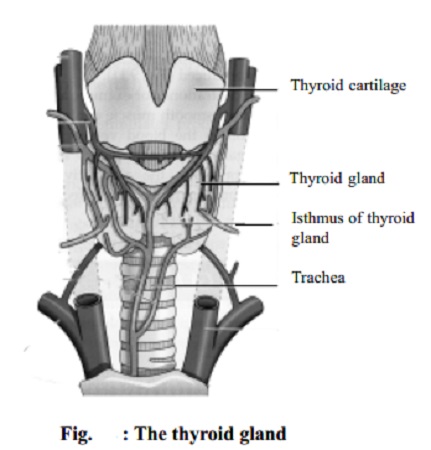Chapter: 11th 12th std standard Home Science Maintain Basic Knowledge for family life Higher secondary school College
Thyroid Gland

Endocrines : The glands of the body may be divided into those with an external
secretion (exocrine glands) and those with an internal secretion (endocrine
glands). Example of exocrine glands are the sweat, Lachrymal and mammary glands
which pass their secretion along the ducts to the external surface of the body
and the glands of the mouth, stomach, and intestine which pass their secretions
along ducts into the alimentary tract. The endocrine or ductless gland on the
other hand have no ducts or openings to the exterior.
The secretions are passed directly into the blood stream and transmitted
to the tissues.
A hormone is a chemical substance produced by the endocrine
glands and their overall function is to regulate the activities of various body
organs and their functions. The first hormone was discovered by Bayliss in
1903.
The main endocrine glands in the body are :
Thyroid
Parathyroid
Islets of Langerhans
Adrenal gland
Pituitary and
Sex glands
THYROID GLAND
The
largest of the endocrine glands is the thyroid, which is located in the neck
region. The thyroid gland weighs 25 gms in a healthy adult. It has two oval
parts called the lateral lobes on either side of the trachea. These two lobes
are connected by a narrow band called isthumus. The entire gland is
enclosed by a connective tissue capsule. This gland produces hormone, thyroxine rich in iodine.
Thyroid
gets iodine from the blood stream. Iodine is formed by the reduction of iodide.
It is then fixed with the amino acid tyrosine to form mono and di-iodo-tyrosine
compounds. Two molecules of di-iodo-tyrosine combine to form thyroxine. By
eating vegetables grown in iodine-containing soils or by eating sea-foods and
iodised salt our diet will have enough iodine necessary for the production of
thyroxine.
Thyroid
stimulating hormone (TSH) produced by the anterior pituitary lobe increases the
activity of thyroid gland. Whenever the thyroxine level falls below a
particular level TSH is stimulated,
Functions of Thyroxine
Helps to regulate tissue growth and development.
Increases the B M R and thus raises the body temperature.
It controls the metabolism by regulating the anabolic and catabolic
process.
Stimulates the cells to break down proteins for energy.
Decreases the breakdown of fats.
Increases the breakdown of body glucose and enhances the glucose
absorption.
Calcium and phosphorus are removed from the bones and excreted in
increased amounts.
Helps in the conversion of Beta-carotene into vitamin A.

Thyroid Disorders
It is of 3
types. They are:
Hypothyroidism
Hyperthyroidism
Simple goitre.
Hypothyroidism
It results
due to lack of thyroid hormone secretion. It results in cretinism in children and
myxoedema in adults.
Cause of Hypothyroidism
Failure or arrest of normal development of thyroid gland.
Failure to form genetic enzymes normally.
Deficiency of iodine in the body.
Administration of antithyroid drugs in excess.
After surgical removal of thyroid gland.
The Chief Features of Cretinism are as follows
Stunted growth
Broad nose
Thick lips
Lobling tongue
Muddy dry skin
Milestones of development in children get delayed e.g., Holding up the
head, sitting, standing, walking gets delayed.
BMR is depressed.
This
disease can be cured if thyroxine or iodine is administered sufficiently.
In adults hypothyrodism causes myxodema which is more common among
females than in males.
The Chief features of hypothyrodism in adults
(Myxoedema)
Decreased BMR
Sexual dysfunction
Lack of energy
Lack of memory
Loss of hair
Dullness
Loss of appetite
Slow heart rate
Gain in weight
Puffy face due to tissue fluid retention.
Hyperthyroidism
Occurs due
to the excessive secretion or over action of thyroxine.
Symptoms of Hyperthyroidism
Enlargement of thyroid gland results in the protrusion of eye ball from
the orbit.
Flushed skin and high temperature
Increased O2 consumption and CO2 output
Tendency to lose weight
The pulse and heart rate are high
Nervousness and irritability
Low resistance to withstand stress and strain
High blood pressure
Mild diabetes
Emotional restlessness
The clinical condition of hyperthyroidism is exophthalmic goitre in which the thyroid gland is usually enlarged
and there is characteristic protrusion of eye balls from the orbit.
Simple Goiter
A lack of dietary iodine may cause endemic goiter. Thyroid gland is
enlarged and has increased number of follicles. This leads to low level of
thyroid hormone in the blood, and derangement of body functions.
Related Topics